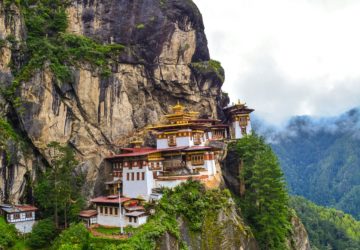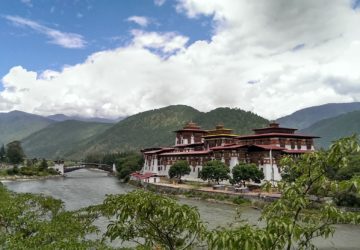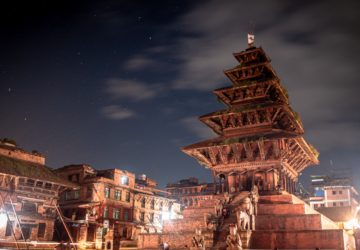9N/10D....
Read More9N/10D Experience Himalayan Kingdoms
Itinerary
On arriving at the Paro International Airport, representative will receive you and escort you to the hotel. After lunch/refreshment in the hotel drive to the National Museum located on a promontory overlooking the valley. Visit the Paro Ringpung Dzong after the museum. The 17th century Dzong still houses the Monk Body and the district administration. In the evening explore the Paro town.
Start the day with a short drive to Sartsam Chorten. From here you hike (1 ½ hours) to the viewpoint of the monastery. The trail climbs through beautiful pine forest, many of the trees festooned with Spanish moss, and an occasional grove of fluttering prayer flags. Stop for a rest and light refreshments at the Taktsang Jakhang (cafeteria) and then walk a short distance until you can see, clearly and seemingly within reach, the Taktsang monastery. The primary Lhakhang was built around Guru Rimpoche’s meditation cave in the 1684 by the Penlop of Paro Gyaltse Tenzin Rabgay, this incredible monastery clings to the edge of a sheer rock cliff that plunges 900 meters into the valley below. Legend has it that Guru Padmasambhava, the tantric mystic who brought Buddhism to Bhutan, flew here on the back of a flying tiger, Dorji Drolo, said to be his favorite consort. After the hike you visit the 7th century Kichu Monastery, enroute back to Paro.
Start with a morning visit to Ta Dzong, which in the past served as watchtower for Paro Dzong and now houses the National Museum; and Paro Dzong (Rinpung Dzong), built in 1646 by Shabdrung Ngawang Namgyal.
This afternoon drive to Haa via the Chelila Pass, the highest road in Bhutan at 4000 meters. On a clear day there are superb views of Mt. Jhomolhari and the Eastern Himalayan Range from this point. Weather permitting, you will hike towards the Haa Valley and enjoy the mountain scenery. Continuing on to Haa (8,811ft), descending all the way for another 22km or approximately one hour’s drive.
After a lunch by the river near the new Haa Dzong, you visit two famous monasteries, Lhakhang Karpo (White Temple) and Lhakhang Nagpo (Black Temple). The central shrine in Lhakhang Nagpo is said to be almost identical to that of the Jowo temple in Lhasa. Legend has it that local deities assisted in the construction of Lhakhanga Karpo. The Bhutanese come here to offer prayers and adorn the hills with prayer flags to pray to the Mountain Gods.
The three giant hills looming over the fringes of Haa are popularly known as ‘RigSum Goenpa’ signifying three deities, Jambayang, Chana Dorji and Chenrezig. These are the three principal bodhisattvas among the thousand future Buddhas to come.
Return to Paro and this evening consider exploring the town on your own.
Depart on a one-hour drive to Thimphu. Along the way you will pass the Simtokha village and Dzong and stop for a visit to the National Memorial Chorten. The building of this landmark was envisaged by the third king, His Majesty Jigme Dorji Wangchuck, as a monument to world peace and prosperity. Completed in 1974 after his untimely death, it is both a memorial to the Late King (“the father of modern Bhutan”) and a monument to world peace.
We then visit the National Library, stocked with ancient Buddhist manuscripts, and the Painting School where traditional art is still kept alive through instructions in the art of painting Thangkas (sacred Buddhist religious scrolls).
After lunch we drive to the Traditional Medicine Institute where medicines are prepared according to ancient practices, and observe a Bhutanese paper factory at work. Other highlights include a visit to the Tashichhodzong. This impressive
fortress/monastery houses the secretariat building, the throne room of His Majesty, the King and various government offices. It is also the summer residence of the Chief Abbot and central monk body; Folk Heritage and National Textile Museums: These museums, both of which opened in 2001, provide fascinating insights into Bhutanese material culture and way of life.
The Handicrafts Emporium is a government-run enterprise and displays a wide range of beautifully hand-woven textiles and craft products. It also carries a small collection of books on Bhutan, Buddhism and Himalayan culture. If you do not find the perfect souvenir here, we will visit the shops of Thimphu before returning to the hotel.
Note: National Library, Institute for Zorig Chusum, National Institute of Traditional Medicine are closed on Sundays and national holidays.
After breakfast, drive north to the trail to the Tango Monastery. The climb about 280m, passes through beautiful forests which are excellent for bird watching, before arriving at the monastery in slightly more than an hour. The Tango monastery (8500m) was built by Lama Gyalwa Lhanampa in the 12th Century and the present building was built in the 15th century by the Divine Madman, Lama Drukpa Kunley. History states that in 1616 The Shabdrung Nawang Namgyal visited Tango and meditated in a cave near the goenpa. His meditations helped ensure the defeat of the invading Tibetan army. The picturesque three-story tower and several surrounding buildings were built in the 18th century by the 8th Desi, Druk Rabgye. The golden roof was added by the Shandrung Jigme Chhogyel in the 19th Century. The Tango monastery as well as the Cheri monastery are the only two Buddhist monasteries that offer a Degree and are the highest centers of Buddhist education. At the monastery you can interact with students of the university and view the great architecture. Nearby are many small retreat centers where many monks meditate for 3 years or 12 years solitary meditation. Later descend down and enjoy a picnic lunch on the way. After lunch drive to Dochula pass (3050m/10130ft) stopping briefly to take in the view and admire the chorten, mani wall and prayer flags that decorate the highest point on the road. A stop for tea along the way at Dochula pass provides an excellent view of the whole range of the Eastern Himalayas if the sky is clear.
This morning you will picked up for a 40-minute ground transfer to airport for your flight to Kathmandu. (Flight cost not included.) Upon arrival you will be met and privately transferred to your hotel. This afternoon, take a short driving tour to the ancient Buddhist stupa at Swayambunath; at first glance you will recognize it as Nepal’s definitive icon. Situated on top of a hill, the stylized eyes of the Buddha look out in all directions. Guarding the lower stairs of the stupa are a band of amusing monkeys performing acrobatics and angling for a snack. Returning to the city, you will have the evening free to relax or explore on your own.
After breakfast, fly to Chitwan. Upon arrival, you are met and transferred to your safari lodge in time for lunch and an afternoon game viewing activity. The Chitwan National Park is in the lush Valley of Chitwan, situated in the foothills of the Churia Ranges, approximately 75 air miles southwest of Kathmandu. Chitwan, meaning ‘heart of the jungle,’ is among the last surviving examples of a continuous band of forest and grasslands which once extended from the Indus River in Pakistan to the Burmese border. The National Park, the first of the Kingdom, is famous for it’s variety of wildlife especially the Great Indian one-horned rhinoceros and the elusive Royal Bengal tiger.
Today partake in jungle safari activities. The main highlights of the safari activities are elephant rides to see the rare one-horned rhino, sloth bear, four species of deer, a dazzling array of tropical birds and perhaps a leopard or tiger. The birdlife is fantastic – some 450 species have been sighted within the park. You will also go by dugout canoe into the watery realm of the threatened gharial crocodile, mugger crocodile, and numerous waterfowl.
After a morning jungle walk, transfer to the airport for your flight to Kathmandu. Upon arrival private transfer to your hotel for check-in. Later, enjoy a half-day tour of Patan City. Patan is a city of Buddhist monuments, Hindu temples, fine wood carvings and known as the paradise of fine arts. Lalitpur is another name of for city that means ‘the city of beauty’.
Good times mostly end leaving behind a trail of golden memories to cherish. After breakfast today, spend some time at leisure. Check out from the hotel and take a transfer to the airport to board a return flight.
Enquiry Now
More you may like!
Nepa Valley Tour Package
3N/4D....
Read MoreAmazing Ladakh Tour
7N/8D....
Read MoreTaste of Nepal Package
15N/16D....
Read More




